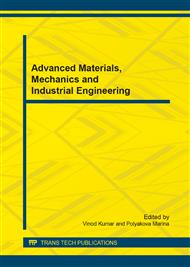[1]
O.W. Richardson, Electron Theory of Matter, Philips Mag., 23 (1912) 594-627.
Google Scholar
[2]
D.M. Goebel, I. Katz, Fundamentals of Electric Propulsion: Ion and Hall Thrusters, JPL Space Science & Technologies Series, John Wiley & Sons, San Francisco, (2008).
Google Scholar
[3]
G.L. Kulcinski, Lecture 5: Basic Elements of Static RTG's [PDF document], retrieved from Lecture Notes Online Website: http: /fti. neep. wisc. edu/neep602/SPRING00/neep602. html.
Google Scholar
[4]
A. Ohashi, K. Ueki, Improvement of a 90Sr radioisotope battery, Radiat. Phys. and Chem., 51(4-6) (1998) 687.
Google Scholar
[5]
G.H. Rinehart, Design characteristics and fabrication of radioisotope heat sources for space missions, Prog. in Nucl. Energy, 39 (3–4) (2001) 305-319.
DOI: 10.1016/s0149-1970(01)00005-1
Google Scholar
[6]
V. Radchenko, et al. Curium-244 alpha-sources for space research. in 4th Topical Meeting on the Industrial Radiation and Radioisotope Measurement Applications (IRRMA'99), October 3, 1999 - October 7, 1999, Elsevier Ltd, Raleigh, NC, USA, (2000).
Google Scholar
[7]
L.S. Mason, Realistic specific power expectations for advanced radioisotope power systems, J. of Propuls. and Power, 23(5) (2007) 1075-1079.
DOI: 10.2514/1.26444
Google Scholar
[8]
B.C. Blanke, J.H. Birden, K.C. Jordan, E.L. Murphy, Nuclear Battery-Thermocouple Type Summary Report, AEC Research and Development Report, Monsanto Research Corporation, (1962).
DOI: 10.2172/4807049
Google Scholar
[9]
A. Sanchez-Torres, Radioisotope Power Systems for Space Applications, Radioisotopes - Applications in Physical Sciences, Prof. Nirmal Singh (Ed. ), ISBN: 978-953-307-510-5, InTech, 2011, DOI: 10. 5772/20928, available from: http: /www. intechopen. com/books/radioisotopes-applications-in-physical-sciences/radioisotope-power-systems-for-space-applications.
DOI: 10.5772/20928
Google Scholar
[10]
K.K. Jameson, D.M. Goebel, and R. Watkins, Hollow Cathode and Thruster Discharge Chamber Plasma Measurements Using High-Speed Scanning Probes, in the 29th International Electric Propulsion Conference, IEPC-2005-269, Princeton University, New Jersey, (2005).
DOI: 10.2514/6.2004-3430
Google Scholar
[11]
D. Herman and A.D. Gallimore, Discharge Chamber Plasma Structure of a 30 cm NSTAR-type Ion Engine, in 40th AIAA/ASME/SAE/ASEE Joint Propulsion Conference and Exhibit, American Institute of Aeronautics and Astronautics, Reston , (2004).
DOI: 10.2514/6.2004-3794
Google Scholar
[12]
G. Dan, J. Polk, and A. Sengupta, Discharge Chamber Performance of the NEXIS Ion Thruster, in 40th AIAA/ASME/SAE/ASEE Joint Propulsion Conference and Exhibit, American Institute of Aeronautics and Astronautics, Reston , (2004).
DOI: 10.2514/6.2004-3813
Google Scholar
[13]
J. Polk, et al., Validation of the NSTAR ion propulsion system on the Deep Space One mission - Overview and initial results, in 35th Joint Propulsion Conference and Exhibit, American Institute of Aeronautics and Astronautics, Reston , (1999).
DOI: 10.2514/6.1999-2274
Google Scholar
[14]
R. Thomas and P. James, An Overview of the Nuclear Electric Xenon Ion System (NEXIS) Activity, in 40th AIAA/ASME/SAE/ASEE Joint Propulsion Conference and Exhibit, American Institute of Aeronautics and Astronautics, Reston , (2004).
DOI: 10.2514/6.2004-3450
Google Scholar
[15]
J. Polk, et al., An overview of the results from an 8200 hour wear test of the NSTAR ion thruster, in 35th Joint Propulsion Conference and Exhibit, American Institute of Aeronautics and Astronautics, Reston , (1999).
DOI: 10.2514/6.1999-2446
Google Scholar
[16]
J.R. Brophy, et al., Ion Propulsion System (NSTAR) DS1 Technology Validation Report, Jet Propulsion Laboratory, California Institute of Technology, Pasadena, (1999).
Google Scholar


